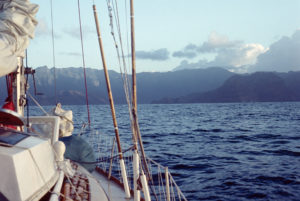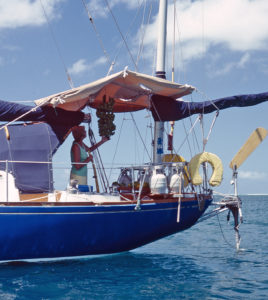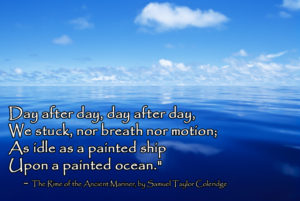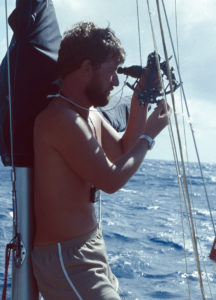
First Landfall: Nuku Hiva, The Marquesas
Note: The following is taken in part from my memoir, Sailing with Impunity: Adventure in the South Pacific.
At our first landfall, The Marquesas, we had an experience we later laughed about, but which at the time was no laughing matter.
Upon Impunity’s arrival and after clearing customs, we were required to surrender our weapons at the police department, more property called gendarme, since French was the official language. We had brought our weapons on our journey in case we should be accosted by pirates at sea, a very real concern in some areas. Before relinquishing them to the local authorities, Bruce had put trigger locks on both our handguns, his Ruger .357 Magnum and my Smith & Wesson .38 Special. We had been warned to lock the triggers so they couldn’t be used by others. The law is that visitors leave the country with the exact weapons and ammunition they had when entering.
Surrendering our weapons made us nervous, but it was the law and we would comply. Luckily, this was the only location we would be visiting in the in the South Pacific where this action was required.
We found the gendarme, a Marquesan, helpful and friendly. He admired our guns and said French weapons lacked accuracy. He spoke a little English and explained that with a French gun you aim here (he pointed) but it shoots there (he pointed in a different direction). We were given a carbon copy of the form we had signed surrendering our guns and about 100 rounds of ammunition.
Two weeks later, when we prepared to leave The Marquesas, we walked the distance to the gendarme station and presented our receipt to the same fellow who had originally taken our guns. His dark face colored as he said, “Yes, well, the Commissioner would like to talk to you.”
“Is there something wrong?” Bruce asked.
“Oh, no, no. But before I can give you your weapons, the Commissioner has asked to see you.”
Oh boy, what was this all about? We followed his directions to a big concrete building, the Commissioner’s residence and office. We were escorted to a large bare room with only a wooden desk in the middle and a chair behind the desk, where the Commissioner sat, and two wooden chairs in front of the desk. A huge ceiling fan slowly rotated above his desk. Tall, shuttered windows lined the outside wall. For some reason, the movie Casablanca popped into my mind.
The Commissioner rose, warmly greeted us and invited us to sit. He could speak very little English and what little he could was difficult to understand. After saying what we supposed was something to the effect he hoped our visit there had been satisfactory, he came to the business at hand. Leaning forward and folding his hands, he directed his attention to Bruce.
“I want to sell your small gun.”
I looked at Bruce’s furrowed brow. He didn’t understand, either.
“Oh!” I said, the Commissioner’s meaning dawning on me. “You want to buy the Smith & Wesson.”
“Yes, yes! That’s it. I want to buy that gun.”
In the first place, what he asked was illegal. I’m sure that’s why the gendarme looked so embarrassed. The law dictated we leave with the exact number of weapons and ammunition with which we arrived. Now the top official on the island was asking us to do something illegal?
In the second place, that was my handgun, a gift from Bruce, and I didn’t want to part with it.
My mind whirled. I glanced at Bruce. He was thunderstruck.
“But you see,” I said, gesturing to Bruce, “my husband gave that gun to me for Christmas. I cannot part with it.” I looked lovingly at Bruce.
The Commissioner was quick to respond. “Oh, but of course. It was a gift from your husband. I do understand.” His manner was gracious and he seemed to completely agree with our position.
The Commissioner stood and shook our hands. “Enjoy the rest of your journey.” At least that’s pretty much what it sounded like.











